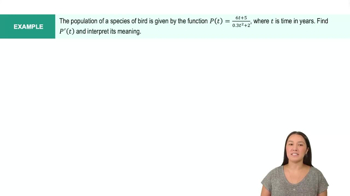Table of contents
- 0. Functions7h 52m
- Introduction to Functions16m
- Piecewise Functions10m
- Properties of Functions9m
- Common Functions1h 8m
- Transformations5m
- Combining Functions27m
- Exponent rules32m
- Exponential Functions28m
- Logarithmic Functions24m
- Properties of Logarithms34m
- Exponential & Logarithmic Equations35m
- Introduction to Trigonometric Functions38m
- Graphs of Trigonometric Functions44m
- Trigonometric Identities47m
- Inverse Trigonometric Functions48m
- 1. Limits and Continuity2h 2m
- 2. Intro to Derivatives1h 33m
- 3. Techniques of Differentiation3h 18m
- 4. Applications of Derivatives2h 38m
- 5. Graphical Applications of Derivatives6h 2m
- 6. Derivatives of Inverse, Exponential, & Logarithmic Functions2h 37m
- 7. Antiderivatives & Indefinite Integrals1h 26m
- 8. Definite Integrals4h 44m
- 9. Graphical Applications of Integrals2h 27m
- 10. Physics Applications of Integrals 2h 22m
2. Intro to Derivatives
Basic Graphing of the Derivative
Problem 3.1.53a
Textbook Question
Owlet talons Let L (t) equal the average length (in mm) of the middle talon on an Indian spotted owlet that is t weeks old, as shown in the figure.<IMAGE>
a. Estimate L' (1.5) and state the physical meaning of this quantity.
 Verified step by step guidance
Verified step by step guidance1
Step 1: Understand the function L(t) which represents the average length of the middle talon of an Indian spotted owlet at t weeks old. The derivative L'(t) represents the rate of change of the talon length with respect to time.
Step 2: To estimate L'(1.5), we need to find the slope of the tangent line to the curve L(t) at t = 1.5. This can be done by finding two points on the curve close to t = 1.5 and calculating the average rate of change between them.
Step 3: Choose two points on the curve, say (t1, L(t1)) and (t2, L(t2)), where t1 is slightly less than 1.5 and t2 is slightly more than 1.5. For example, you might choose t1 = 1 and t2 = 2.
Step 4: Calculate the average rate of change between these two points using the formula: \( \frac{L(t2) - L(t1)}{t2 - t1} \). This will give an approximation of L'(1.5).
Step 5: Interpret the physical meaning of L'(1.5). It represents the rate at which the length of the middle talon is growing at 1.5 weeks. A positive value indicates growth, while a negative value would indicate a decrease in length.
 Verified video answer for a similar problem:
Verified video answer for a similar problem:This video solution was recommended by our tutors as helpful for the problem above
Video duration:
4mPlay a video:
Was this helpful?
Key Concepts
Here are the essential concepts you must grasp in order to answer the question correctly.
Derivative
The derivative of a function measures the rate at which the function's value changes as its input changes. In this context, L'(t) represents the instantaneous rate of change of the average length of the owlet's talon with respect to time, indicating how quickly the talon length is growing at a specific age, t.
Recommended video:

Derivatives
Average Length Function
The function L(t) describes the average length of the middle talon of the Indian spotted owlet as a function of its age in weeks. Understanding this function is crucial for estimating L'(1.5), as it provides the necessary data to analyze how the talon length varies over time.
Recommended video:

Average Value of a Function
Physical Interpretation
The physical meaning of L'(1.5) relates to the biological growth of the owlet. Specifically, it indicates how much the average length of the talon is expected to increase per week when the owlet is 1.5 weeks old, providing insight into the growth patterns of this species.
Recommended video:

The Quotient Rule Example 5

 6:15m
6:15mWatch next
Master Graphing The Derivative with a bite sized video explanation from Nick
Start learning




